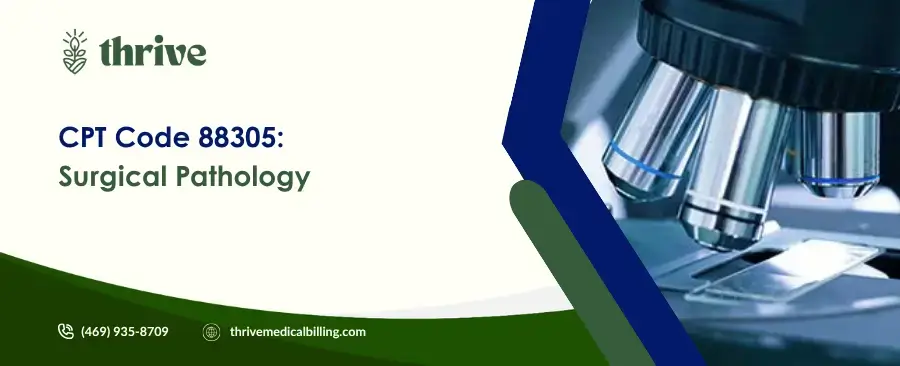Introduction to 88305 CPT Code Definition
CPT code 88305 is a procedural code used in medical billing to describe a surgical pathology service, specifically the gross and microscopic examination of tissue specimens at a level IV complexity. This code is part of the Current Procedural Terminology (CPT) system maintained by the American Medical Association (AMA) and is widely used in histopathology to evaluate tissue samples for diagnostic purposes. Understanding the 88305 CPT code definition is essential for pathologists, laboratory professionals, and billing specialists to ensure accurate billing and avoid issues that lead to claim denials.
This guide provides a detailed overview of CPT code 88305, its applications, modifiers, Medicare reimbursement rates, and strategies to optimize billing for tissue examination procedures used in diagnosing various medical conditions.
What is Surgical Pathology and CPT Code 88305?
Surgical pathology involves the examination of tissue specimens obtained during surgical procedures, biopsies, or other medical interventions to diagnose diseases such as cancer, infections, or inflammatory conditions. CPT code 88305 represents a level IV surgical pathology procedure, which includes both gross examination (visual inspection of the tissue) and microscopic examination (analysis of tissue under a microscope after processing and staining).
This code is used for moderately complex tissue specimens, such as colon biopsies, prostate biopsies, or skin excisions, requiring detailed histopathology analysis. The 88305 CPT code definition specifies the professional and technical work involved in preparing and interpreting these specimens, making it a cornerstone of diagnostic pathology services.
Procedure Involving CPT Code 88305
The procedure involving CPT code 88305 includes the following steps:
- Specimen Collection: Tissue is obtained via biopsy, excision, or surgical resection (e.g., colon polyp, breast lump, or skin lesion).
- Gross Examination: A pathologist visually inspects the tissue, noting its size, color, texture, and any visible abnormalities.
- Tissue Processing: The specimen is fixed (e.g., in formalin), embedded in paraffin, sectioned into thin slices, and stained (e.g., with hematoxylin and eosin) for microscopic analysis.
- Microscopic Examination: The pathologist examines the tissue under a microscope to identify cellular abnormalities, such as cancerous cells, inflammation, or infection.
- Reporting: A detailed pathology report is generated, documenting the findings and providing a diagnosis or recommendations for further testing.
The procedure is performed in a Clinical Laboratory Improvement Amendments (CLIA)-certified laboratory, typically by a board-certified pathologist. CPT code 88305 is used for specimens requiring moderate complexity, distinguishing it from lower or higher complexity codes.
Comparison with Related CPT Codes
CPT code 88305 is part of the surgical pathology code set, which varies based on the complexity of the tissue examination. Here’s how it compares to related codes:
- CPT Code 88302: Represents level II surgical pathology, used for simple specimens like fallopian tube sterilization or hernia sacs.
- CPT Code 88304: Covers level III surgical pathology, for slightly less complex specimens than 88305, such as simple cysts or lipomas.
- CPT Code 88307: Describes level V surgical pathology, for more complex specimens like bone marrow biopsies or entire organ resections.
- CPT Code 88309: Represents level VI surgical pathology, the highest complexity, used for specimens like radical mastectomies or tumor resections with extensive analysis.
Choosing the correct procedural code is critical to ensure accurate billing. For example, billing CPT code 88305 for a simple cyst (88304) or a complex organ resection (88307) can lead to claim denials.
Modifiers for CPT Code 88305
Modifiers provide additional context for CPT code 88305 to ensure proper reimbursement. Common modifiers include:
- Modifier 26 (Professional Component): Applied when billing only for the pathologist’s interpretation of the tissue, excluding technical laboratory costs.
- Modifier 52 (Reduced Services): Indicates a partially performed procedure, such as gross examination without microscopy due to specimen inadequacy.
- Modifier 59 (Distinct Procedural Service): Denotes a separate procedure on the same day, such as CPT code 88305 for multiple distinct specimens (e.g., multiple colon biopsies). Use cautiously to avoid unbundling issues.
- Modifier 76 (Repeat Procedure by Same Physician): Indicates the same pathologist repeated the procedure on the same day, e.g., for additional specimens.
- Modifier 77 (Repeat Procedure by Another Physician): Used when a different pathologist repeats the procedure.
- Modifier 91 (Repeat Clinical Diagnostic Laboratory Test): Applied when the same test is repeated on the same day to obtain additional results.
- Modifier 99 (Multiple Modifiers): Used when multiple modifiers apply to the procedure.
Providers must adhere to AMA and payer guidelines, including Medicare’s National Correct Coding Initiative (NCCI) edits, to avoid errors that lead to claim denials.
Medicare Reimbursement Rates for CPT Code 88305
CPT code 88305 is reimbursable by Medicare, but reimbursement rates vary based on several factors:
- Clinical Laboratory Fee Schedule (CLFS): Surgical pathology codes like CPT code 88305 are reimbursed under the CLFS for technical components and the Medicare Physician Fee Schedule (MPFS) for professional components.
- Geographic Adjustments: Rates are adjusted based on the Geographic Practice Cost Index (GPCI) or regional Medicare Administrative Contractors (MACs).
- Technical vs. Professional Component: Reimbursement differs when billing the technical component (laboratory costs), professional component (Modifier 26), or global service.
- Coverage Policies: Medicare coverage for CPT code 88305 requires medical necessity, as outlined in Local Coverage Determinations (LCDs) or National Coverage Determinations (NCDs).
To verify reimbursement rates for 2025, providers should:
- Check the CLFS and MPFS on the Centers for Medicare & Medicaid Services (CMS) website.
- Consult their regional MAC for specific coverage policies and billing rules.
- Use coding tools like AAPC Coder or Pathology Billing Services for rate estimates.
Accurate documentation of medical necessity, such as suspected malignancy or inflammatory conditions, is critical for Medicare reimbursement.
Conditions Diagnosed with CPT Code 88305
CPT code 88305 is used to diagnose a wide range of conditions through histopathology and tissue examination, including:
- Cancers: Such as colorectal cancer (colon biopsies), prostate cancer (prostate biopsies), or melanoma (skin excisions).
- Inflammatory Conditions: Including inflammatory bowel disease (e.g., Crohn’s disease, ulcerative colitis) or gastritis.
- Infections: Identifying bacterial, viral, or fungal infections in tissue samples.
- Benign Lesions: Such as polyps, fibroadenomas, or lipomas requiring histopathological confirmation.
- Autoimmune Disorders: Diagnosing conditions like lupus or vasculitis through tissue analysis.
The moderate complexity of CPT code 88305 makes it suitable for common biopsy specimens requiring detailed microscopic examination.
Medical Billing Best Practices to Ensure Accurate Billing
To ensure accurate billing for CPT code 88305 and minimize issues that lead to claim denials, providers and laboratories should adopt the following medical billing strategies:
- Train Coders: Educate staff on the 88305 CPT code definition, its differences from codes like 88304 or 88307, and appropriate modifiers.
- Use Laboratory Information Systems (LIS): LIS with integrated coding tools streamline documentation and reduce errors.
- Document Medical Necessity: Clearly note indications like suspected cancer, abnormal findings, or clinical symptoms to justify the procedure.
- Verify Payer Guidelines: Confirm Medicare and private payer rules for CPT code 88305, especially regarding bundling with other pathology codes.
- Conduct Regular Audits: Review claims to identify and correct coding or billing errors before submission.
These practices optimize revenue cycle management and improve financial outcomes for pathology practices.
Common Errors That Lead to Claim Denials
Billing errors for CPT code 88305 can lead to claim denials, delaying reimbursement. Common mistakes include:
- Incorrect Code Selection: Billing CPT code 88305 for a less complex specimen (88304) or a more complex specimen (88307).
- Improper Modifier Use: Applying Modifier 59 without clear distinction for multiple specimens or using Modifier 26 inappropriately for global billing.
- Inadequate Documentation: Failing to document medical necessity, such as clinical indications or biopsy findings.
- Unbundling Errors: Billing CPT code 88305 with other pathology codes without justification, violating NCCI edits.
- Outdated Guidelines: Not adhering to the latest AMA, CMS, or CLIA regulations for surgical pathology.
Providers should verify codes, modifiers, and documentation to ensure accurate billing and avoid denials.
Conclusion and Resources
CPT code 88305 is a critical procedural code for surgical pathology, enabling tissue examination to diagnose conditions like cancer, infections, and inflammatory disorders through histopathology. By understanding the 88305 CPT code definition, its modifiers, Medicare reimbursement rates, and best practices for medical billing, providers can ensure accurate billing and minimize issues that lead to claim denials. For further guidance, consult:
- CMS Website: For CLFS, MPFS, and reimbursement rates.
- American Medical Association (AMA): For CPT code updates and guidelines.
- College of American Pathologists (CAP): For resources on surgical pathology and histopathology.
By staying informed and proactive, healthcare providers and laboratories can optimize billing for CPT code 88305 and enhance patient care through accurate diagnostics.








